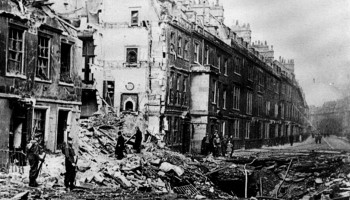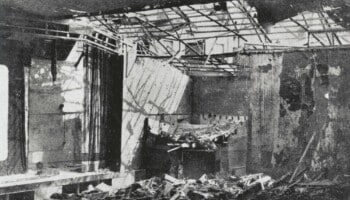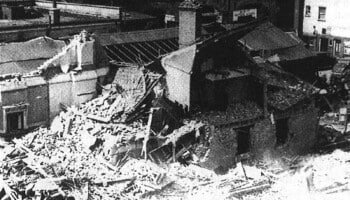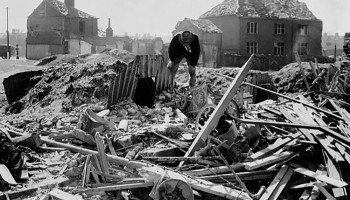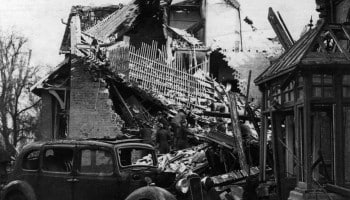Home » Resources » UXO City Guides »
UXO City Guide
Home Office Bombing Statistics for Bristol
Record of German Ordnance dropped on the County Borough of Bristol
High Explosive Bombs (All types)
6,184
Parachute Mines
2
Oil Bombs
17
Phosphorus Bombs
0
Fire Pots
0
Pilotless Aircraft (V-1)
0
Long-range Rocket Bombs (V-2)
0
Weapons Total
6,203
Area Acreage
24,406
Number of items per 1,000 acres
254.2
Why was Bristol targeted and bombed in WWII?
Bristol, located within the south-west of England, sustained a significant amount of bombing due to its concentration of industrial features, including several docks and areas of aircraft industry.
This made it an obvious target for the Luftwaffe. Some key targets in Bristol were the ‘Bristol Floating Docks’, ‘Bristol Gasworks’, ‘Prince Wharf Granary’, ‘Bathurst Basin’ and ‘Albion and Wapping Docks.’
Various defensive features were constructed in an attempt to protect the city. However, the distinctive waterway running through the area formed a natural flight path between Avonmouth and Bristol City Centre – which made it very difficult to camouflage key target locations.
Home Office Bombing Statistics for Bristol
Details obtained from the official Home Office bombing statistics, indicates the quantity and type of bombs that fell on the County Borough of Bristol during WWII (excluding incendiary bombs).
A total of 6,203 bombs fell on Bristol, equating to an average of 254.2 items of ordnance recorded per 1,000 acres.
However, this does not account for any bombs that fell unrecorded during these heavy raids, many of which fell into areas that had already been previously bombed. These unidentifiable items, falling unnoticed are what pose a potential risk to construction today.
Major bombing raids on Bristol
Throughout the war, Bristol was subject to approximately 548 raids, eleven of which were considered to have been extensive in nature.
Some of the other major attacks on the city occurred on these dates.
- 24th November 1940
- 3rd and 6th December 1940
- 3rd, 4th and 16th January 1941
- 16th and 29th March 1941
- 3rd, 4th and 11th April 1941 (Good Friday Raids)
Below is an extract of a bomb map showing the locations of bomb strikes and roads blocked as a result of the Good Friday Raids, obtained from the Bristol Archives. H.E bombs are shown as blue dots, incendiary bombs as red, green dots with an ‘x’ as confirmed U.X.B’s and unfilled ‘x’s as unexploded A.A shells.
A red line is used to show which roads were blocked. This map highlights the extent of bombing sustained by Bristol from a singular raid, and therefore highlighting the likelihood of a UXO going missing throughout the war.
In total, 1,299 people were killed during the bombing over Bristol, and over 89,000 buildings were damaged including around 84,000 homes. Between 24th November 1940 and 11th April 1941, there were six major bombing raids, and overall, 548 air raid alerts and 77 air raids1.
The bombing transformed many areas of the city post-war. Among the most notable was Bristol’s main shopping district, Broadmead. Pre-war, Castle Street was the shopping hub, but German bombing raids reduced almost every building in the district to rubble leading the council to create the Castle Park development in the 1960’s and create a shopping centre in Broadmead.
Today, anyone walking along the Floating Harbour from Bristol Bridge, into Castle Park, up to the top of Union Street and back down to the top of Corn Street would have little idea that they’d just strolled around what was the city centre of Bristol for centuries2.
Can UXO still pose a risk to construction projects in Bristol?
The primary potential risk from UXO in Bristol is from items of German air-delivered ordnance which failed to function as designed.
Approximately 10% of munitions deployed during WWII failed to detonate, and whilst efforts were made during, and after the war to locate and make UXBs safe, not all items were discovered.
This is evidenced by the regular, on-going discoveries of UXO during construction-related intrusive ground works across the UK – not just in Bristol.
Occasionally items of British explosive ordnance are also encountered – often associated with WWII defensive measures or Home Guard operations. However, there were few military related facilities in or around the city.
I am about to start a project in Bristol, what should I do?
Developers and ground workers should consider this potential before intrusive works are planned, through either a Preliminary UXO Risk Assessment or Detailed UXO Risk Assessment. This is the first stage in our UXO risk mitigation strategy and should be undertaken as early in a project lifecycle as possible in accordance with CIRIA C681 guidelines
It is important that where a viable risk is identified, it is effectively and appropriately mitigated to reduce the risk to as low as reasonably practicable (ALARP). However, it is equally important that UXO risk mitigation measures are not implemented when they are not needed.
While there is certainly potential to encounter UXO during construction projects in Bristol, it does not mean that UXO will pose a risk to all projects. Just because a site is located in Bristol does not mean there is automatically a ‘high’ risk of encountering UXO. It really does depend on the specific location of the site being developed.
A well-researched UXO Risk Assessment will take into account location specific factors – was the actual site footprint affected by bombing, what damage was sustained, what was the site used for, how much would it have been accessed, what were the ground conditions present etc.
It should also consider what has happened post-war – how much development has occurred, to what depths have excavations taken place and so on. This will allow an assessment of the likelihood that UXO could have fallen on site, gone unnoticed and potentially still remain in situ.
Recent UXO discoveries in Bristol
Since the war, many items of UXO have been discovered across multiple cities within the UK, with Bristol no exception. See the news articles below about UXO incidents and discoveries from national and local press in Bristol.
1st Line Defence keep up-to-date with relevant and noteworthy UXO-related news stories reported across the UK, and you can browse through these articles using the buttons below.
Get UXO risk mitigation services from a partner you can trust
UXO City Guides
Got a project in Bristol? Need advice but not sure where to start?
If you need general advice about UXO risk mitigation in Bristol, contact us and we will be happy to help.
Contact Us
* indicates required fields







